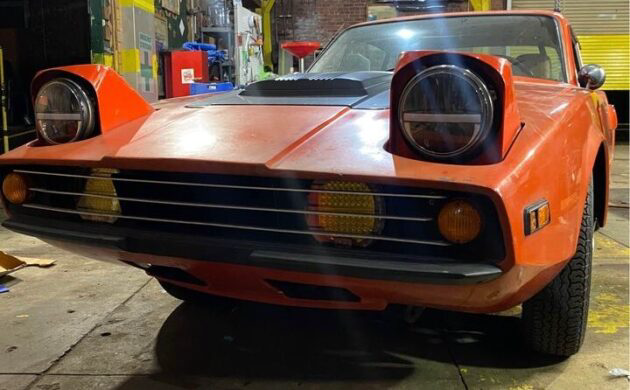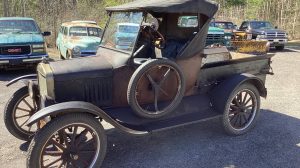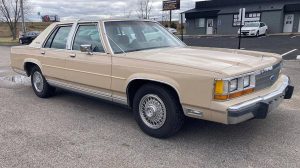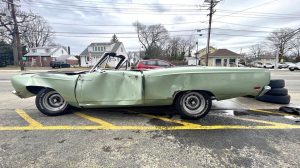Saab of Sweden was an innovative automobile manufacturer with a long history. They built their first car in 1945 and stuck around for nearly 70 years before running out of gas (i.e., money). One of their more interesting machines was the little Sonett, a 2-seat enclosed sports car that was largely built for the U.S. market. This 1971 edition has a Ford V4 engine and it’s still in regular use. From Middlefield, Connecticut, this interesting runabout is/was available here on Facebook Marketplace for $9,800. Thanks for the neat tip, Healeydays.
The Sonett had two incarnations, first from 1955 to 1957 and again from 1966 to 1974. The early ones were built in small quantities that were often used for racing. The latter ones are what came to the U.S. to compete in the growing sports car market then dominated by the Brits. The Sonett drew from existing inventory for their underpinnings, like the Saab 93, 95, and 96, but the bodies were made of fiberglass so the tiny cars weighed little more than 1,700 lbs. The Sonett went through a few iterations before getting to the Sonett III which lasted from 1970 until demand ran out in 1974.
Under the hood of the Sonett III (and presumably the seller’s car) was a 1,700-cc Ford of Europe Taunus V4 engine that produced 65 hp. That was enough power to propel the Sonett III from 0 to 60 mph in under 13 seconds with a top speed of about 112. It attracted buyers who might otherwise have been looking to buy an MG Midget, MGB, Triumph TR5, or Austin Healey. One of the interesting features of the Sonett III was it had a dashboard that was wrinkle-finished in black. Over its five years, the Sonett III saw just 8,368 assemblies so they’re kind of rare today.
The seller’s Saab has only 50,000 miles, but it’s still driven several times a week. We’re told it performs well and the V4 engine has a distinctive sound, which attracted the seller to the car some time ago. We’re told the fiberglass body is okay but does have a few, easily fixable cracks. The orange paint could stand some attention, too. The interior is finished in brown leather which looks fine but appropriately used. The seller says he/she doesn’t really want to get rid of the car, but some of the photos show other toys that may need assistance.














there were a few of these in the stuffed into a driveway on my school bus route as a wee lad. orange, yellow….and maybe blue? or was it green?
anyway i fancied them as they were clearly a sportscar. they were still there a dozen years later when i was in high school, then disappeared.
i think i recall dad saying they had 2-cycle engines though?
Early models, the I and II had a two cycle, yes. Love these little cars. Typically fail from fatal rust in the chassis. A PPI is always warranted.
The first Sonnets (Sonnet I and early Sonnet II) had two-cycle engines. The V4 in this Sonnett III is a 4-stroke design, originally intended for the stillborn 1963 Ford Cardinal front-drive subcompact here in the U.S. (Curiously, Ford used Saab 93s as test mules for that car and of course later the V4 wound up being used in Saabs.)
Ford pulled the plug on the Cardinal at the last minute, reportedly over concerns about costs, but the German version (Taunus) went on to be produced and that’s where Saab V4 engines came from.
https://www.curbsideclassic.com/curbside-classics-european/automotive-history-how-the-american-ford-fwd-cardinal-became-the-ford-taunus-12m-from-dearborn-with-love/
I think SAAB ( Svenska Aeroplan Aktiebolaget) was a Swedish jet-fighter manufacturer with a bunch of bored Aeronautical Engineers who spent the long winters thinking about automobiles. The came up with some very cool cars. The 9-3 Viggen was the best of the bunch in my opinion. Too quirky for many, but I liked the fact you didn’t see them all over the place.
Ten weeks on Market Place and no takers yet.
Hard to swallow calling it a “sports car” with a 0-60 time of almost 13 seconds!!
It may handle since it’s only 1,700 lbs but I’d need a 0-60 time of at least single digits.
Motorcityman, just about every affordable sports car of that era that did not have a V-8 had 0-60 times of greater than 10 sec.
The ONLY Saab ever built with good styling and not looking like something from the 1940s.
Nine, count em, nine pictures of the driver’s side of the car and not one pic of the passenger side.
Take a picture of the front, back, left side, right side, interior and engine bay at a bare minimum. That’s six photos that tell far more of the story than nine pictures of the same side.
It’s not rocket surgery, just take pictures of the thing you’re selling.
Rant over, I’ll see myself out now.
I see the owner did the requisite installation of driving/aircraft lights in the buckets behind the grill.
Looked at one, new, still sitting in Saab dealer,’s showroom in spring of 76.
It’s a good looking ride imop, the motor just isn’t there.
It looks very narrow, wonder how stable it is when pushed in the twisties??
Anyone ever try to drive one hard?
Once saw one of these at a local car show with a 900S 16v powertrain swapped in, giving it the motor its looks promised. That said, the hood was off, if it even had one, so I can’t vouch how tidy (or not) it would have looked fully buttoned-up.
These are very stable and good-handling cars, quite fun. Front drive, light weight, low center of gravity, quick accurate steering.
SAAB 96’s could be driven at breakneck speeds and handled as if on rails. As much lower as these are, you should be able to handle any speed and road condition with safety and security, while still going like stink! The rear suspension on these (and 95’s and 96’s) was very compliant over road irregularities while at the same time exhibited inherent roll stiffness, the end result being a comfortable ride with great roadholding and cornering. Combine that with front wheel drive and you’ve got a winner, summer or winter.
The combination of tall, skinny tires and the low center of gravity provided for great handling in these cars. I have had the opportunity to drive both a Sonnet II and Sonnet III under twisty road conditions. Plenty of torque steer and accelerating halfway through the corner pulls this little car through like it was meant to be.
Appreciate your response but “tall skinny tires” makes for POOR handling.
@Motorcityman if you already think you know the answer, why did you ask the question?
The cars handle very well, tall skinny tires or not. So did a lot of other cars of that day, such as the Alfa Duetto, MGB and Porsche 912, just to name a few.
Could be a nice buy but it all depends on whether or not there’s rust in the usual areas on these…the rockers and the tray under the battery were notorious for returning to the earth. The Sonett III, and the Sonett V4 that was its predecessor, benefitted from the Taurus powerplant. The 2 stroke Sonett II was a fun novelty but not really sustainable in a modern 4 stroke world.
Handling? Yes, they handle like go-karts, but be warned that if you’re over say 5’11 ish they’re going to be cramped…think Europa size car when you’re finally shoehorned in and got your feet in the pedals. You have a little more room in a Sonett over the Lotus because that big coffin shift box/console isn’t in the way
The later first generation cars came here as well.
Great looking cars, but I could never fit in one, and I did try.
Back when I used to fly gliders, our towplane pilot had a sonnett with some sort of ‘freewheeling’ feature. When he’d let off the gas, the car just kept going; no engine braking, so it was all on the brakes and aerodynamic drag to slow the car down. It was very noticeable and odd. I’d never heard of such a thing before nor have I since.
The free-wheel in Saabs were an engineering artifact that was carried over from their older 2 stroke engines. If you are ‘engine braking’ you’re essentially cutting of fuel flow and in a 2 stroke, where the fuel flow is also lubricating the top end of the engine, and that would be catastrophic in a long downhill so disconnecting the final drive from the engine prevented this.
Oil injection that’s independent of the throttle and works off engine RPM (Suzuki’s CCCI system on its 2-strokes) would have been a better and cheaper arrangement.
They did have free wheeling, a holdover from the two-stroke days.
You could lock it out with a little lever.
Interesting but..only one side of the car is well-photographed, and that car has a lot more than 55k miles on it, by the looks of that driver’s seat.
PAUL B…..I asked the question because I felt like it, is that ok with you? If not too bad, go get a attitude adjustment.